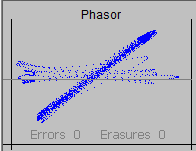
Based on the work of Phil Karn - KA9Q I have implemented a new BPSK Decoder for FoxTelem. After my talk at the AMSAT symposium, where I explained the Fox-1E BPSK endcoder and Costas loop decoderE, he pointed out that a Costas Loop is vulnerable to fading and loses track of the carrier. He suggested that a Dot Product decoder was a better approach. So I set out to see if that was true. Step 1 was understanding how a Dot Product BPSK decoder works and then implementing it in FoxTelem.
 A dot product is the product of two vectors. In this case we are going to be looking at the phase vector of the BPSK signal. In the phasor diagram to the right you see the phase vector plotted for many bits. This is a straight line because it is showing two phases that are 180 degrees apart, which sounds right for BPSK. In this case they are about 45 degrees and 225 degrees. It is a line rather than two dots because the amplitude is changing for each bit. This may well be an issue that needs to be addressed in the decoder.
A dot product is the product of two vectors. In this case we are going to be looking at the phase vector of the BPSK signal. In the phasor diagram to the right you see the phase vector plotted for many bits. This is a straight line because it is showing two phases that are 180 degrees apart, which sounds right for BPSK. In this case they are about 45 degrees and 225 degrees. It is a line rather than two dots because the amplitude is changing for each bit. This may well be an issue that needs to be addressed in the decoder.
Our signal is differentially encoded, making it DBPSK, and meaning that the absolute phase does not matter. We don't need it to oscillate between 0 and 180. Instead if the phase changes from one bit to the next then we have a "0", if the phase stays the same then we have a "1".
If we take the dot product of the phase from one bit and multiply it by the phase from the next bit, then we have a clear indication if the phase has changed. If the phase is the same then the dot product of two identical vectors is a vector with twice the length. If the phase is the opposite then the dot product should be zero. This is much less sensitive to phase inaccuracies than the Costas loop, which has to be locked to 0 and 180 degrees.
We still need to be on the right frequency, even if we can tolerate some phase shift, and we still need to align with the data. That means we need to recover the carrier and the clock. The dot product calculation is very fast because it is not a convolution. So we simply run the calculation many times at different offsets and use the maximum magnitude (energy) to determine when we are aligned.
You can see the details in the FoxTelem code or look at Phil's original implementation in C. Broadly they both do the following:
In my next post I compare the performance of the Dot Product Decoder to the Costas Loop
73
Chris
g0kla/ac2Cz
Enter Comments Here:
Copyright 2001-2021 Chris Thompson
Send me an email